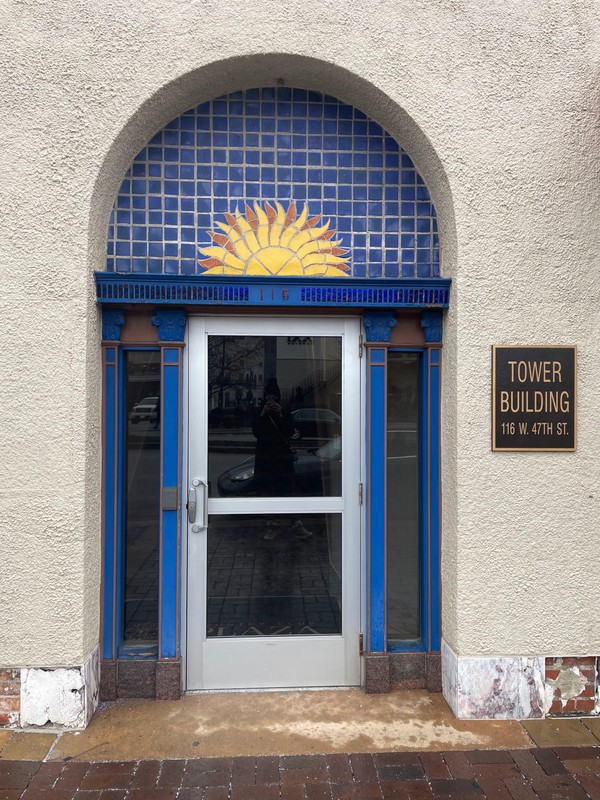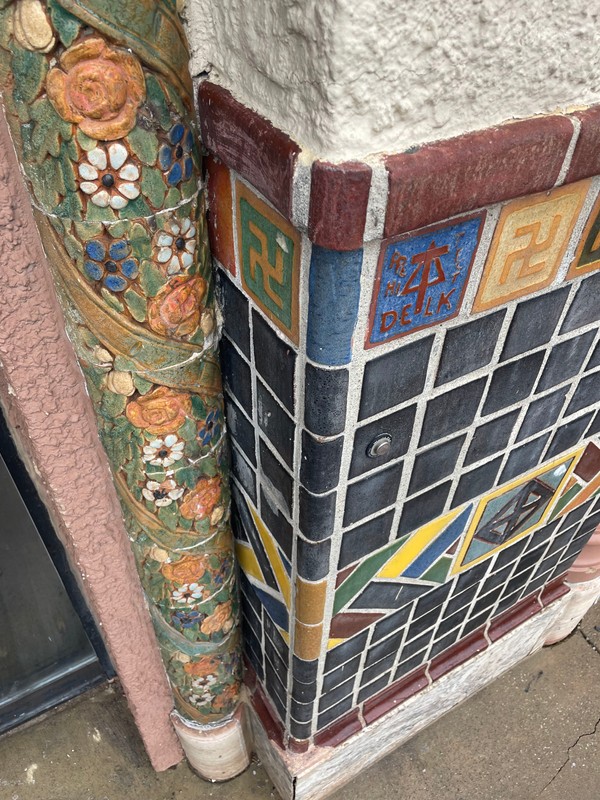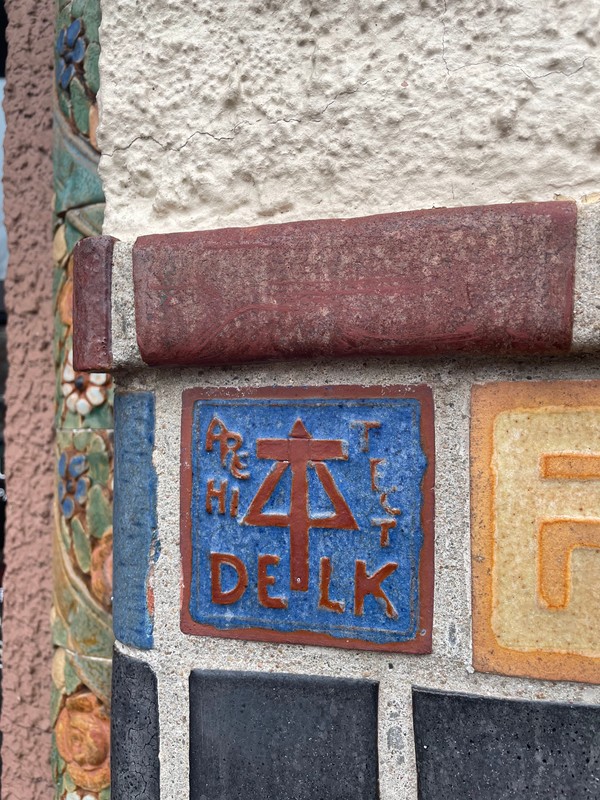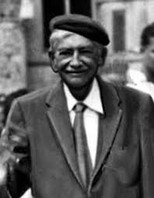Plaza Tower Building
Introduction
Author-Uploaded Audio
Local historian Bill Worley gives a background on the architecture and unique tiles of the Tower Building.
Text-to-speech Audio
Designed in 1923 by architect Edward Buehler Delk, the Plaza Tower Building was the first building on the Plaza to include a tower in its original design. It features Spanish inspired elements and the roof is crowned with a Flemish gable, adding architectural interest. Colorful tile and terracotta detail adorn the building's entrances and tower, including a tile that serves as Delk’s signature and several other tiles that occasionally arouse concern among area residents given their resemblance to a symbol that was utilized by fascists over a decade after the building’s construction (more detail below). As the Plaza began drawing business from downtown, Nichols strategically planned a unique mix of stores. The Tower Building opened with a woman’s dress and accessory shop, and within the same month other tenants included a hardware store, Ford auto agency, and an art gallery. It continues to house retail and restaurant space, and business offices on the upper level.
Images
The Plaza Tower Building was the first building with a tower erected on the Country Club Plaza.

Colorfully glazed tile adorns a doorway to the Tower Building

An up close look at the terracotta and tile detail surrounding the tower entrance of the Tower Building, including the Delk tile and several featuring reverse swastikas.

One of the tiles surrounding the base of the Tower Building's tower honors its architect Edward Buehler Delk

Architect Edward Buehler Delk. Courtesy of Missouri Valley Special Collections, Kansas City Public Library.

Backstory and Context
Text-to-speech Audio
The Plaza Tower Building was one of the first buildings designed for the Country Club Plaza and the first to include a European style tower, which became a common architectural theme for the district. Designed by Edward Buehler Delk in 1923, the two level building features elements of Spanish architecture and a Flemish gable lined in red brick. The seventy-foot tower resides on the southeast corner of the building and includes arched entrances, upper level balconies, spiral pilasters, ornate terra cotta moldings that adorn the doorways and glazed tiles that wrap around the base.
J. C. Nichols strategically chose the merchants on the Plaza with an intentional mix of everyday needs and unique stores, often referring to the group of shops as “one large department store.” Within its first year, the Plaza began drawing business away from downtown. One of the first tenants to the Tower Building was the Avon Shop, a woman’s dress and accessory store, which opened on October 1, 1924. Other occupants opening the same month were a beauty parlor, dressmaking shop, hardware store, Ford auto agency, radio equipment store, stationery supplier, and an art gallery. In 1936, a small building was built to the east of the tower, originally the site of a Sinclair filling station, which connected the Tower Building to the Suydam Building, the Plaza’s first built building.
Within the tiles on the southeast corner of the Tower Building, is one commemorating Edward Buehler Delk. The bright blue tile features his last name D-E-L-K and the word architect artistically arranged (ARC-HI-TECT) around a square and triangle, which are the tools of an architect. Notably on either side of Delk’s tile, are several tiles that contain a symbol that was utilized by fascists over a decade after this building’s completion.
While the swastika has been closely associated with Adolf Hitler and Nazism, the origins of the swastika date back over 10,000 years and is believed to have symbolized health, fertility, and good fortune. The tiles on the Plaza are reverse swastikas, and it is important to note that prior to its association with European fascism, variations of this design were used by cultures all around the world for many purposes, including in Hinduism, Buddhism, and Jainism; patterns in ancient Asian art; in Greek currency; in Medieval and Renaissance architecture; in African pottery; and in Native American and southwestern tribes during healing ceremonies. Demonstrating how the meaning of symbols can change throughout history, the association of the swastika design with German Nazis during and after World War II has the occasional eagle-eyed visitor to the Plaza to express understandable concern about these tiles.
Architect Edward Buehler Delk was born in Schoharie, New York in 1885. He graduated from the University of Pennsylvania in 1907 and the following year, toured Italy and Greece to study Greek and Roman architecture. He served in the Air Force during WWI but stayed in Europe to study city planning at the University of London. He came to Kansas City in 1920 after accepting an invitation to serve as a consulting architect for the J. C. Nichols Company on the Country Club Plaza project. For inspiration in planning the Plaza, he traveled to Spain, Mexico, and South America with partners from the Hare & Hare Company and George E. Kessler (1862-1923), a German born landscape architect who helped shape parks and boulevards throughout Kansas City. Upon return, Delk’s work began with designing the Suydam and the Tower Buildings. He designed many buildings, homes, and churches throughout his long career, including working with Frank Lloyd Wright in 1940 on two projects and designing the Starlight Theater in 1950. Delk has been awarded the prestigious Gold Medal by the American Institute of Architects and has several pieces of work on the National Register of Historic Places.
Sources
Country Club Plaza Walking Guide, Historic Kansas City. Accessed January 8th 2022. https://www.historickansascity.org/wp-content/uploads/2018/04/98973-Historic-KC-LR_nocrops.pdf.
The Avon Shop, The Pendergast Years. Accessed January 8th 2022. https://pendergastkc.org/collection/10554/k0054-v07p188-01/avon-shop.
Worley, William S.. J. C. Nichols and the Shaping of Kansas City: Innovation in Planned Residential Communities. University of Missouri Press, 2013.
Jezak Ford, Susan. Biography of Edward Buehler Delk (1885-1956), Architect, The Kansas City Public Library. Accessed January 8th 2022. https://kchistory.org/document/biography-edward-buehler-delk-1885-1956-architect.
McDermott, Mat. 10 Things You Need to Know About the Swastika, Hindu American Foundation. November 3rd 2016. Accessed April 18th 2022. https://www.hinduamerican.org/blog/10-things-you-need-to-know-about-the-swastika/.
Nichole Stahly, personal photo
Nichole Stahly, personal photo
Nichole Stahly, personal photo
Nichole Stahly, personal photo
https://kchistory.org/document/biography-edward-buehler-delk-1885-1956-architect
